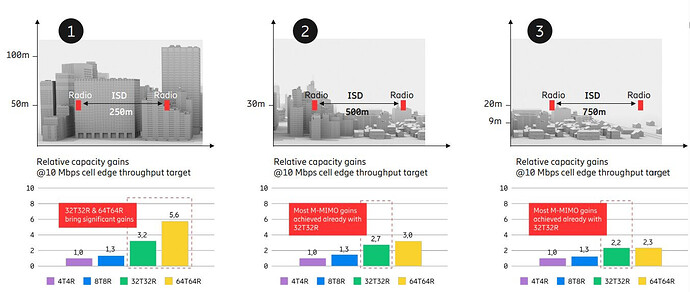![]() Beamforming in the vertical dimension impacts capacity in different deployment scenarios.
Beamforming in the vertical dimension impacts capacity in different deployment scenarios.
![]() The examples compare capacity gains of 4T, 8T, 32T and 64T antenna configurations in dense urban, urban mid-rise, and suburban environments.
The examples compare capacity gains of 4T, 8T, 32T and 64T antenna configurations in dense urban, urban mid-rise, and suburban environments.
![]() In dense urban high-rise buildings:
In dense urban high-rise buildings:
- Massive MIMO (32T and 64T) provides substantial gains over RRUs (4T and 8T)
- 64T64R significantly outperforms 32T32R
- Both horizontal and vertical beamforming are useful due to user spread
![]() In urban mid-rise buildings:
In urban mid-rise buildings:
- Massive MIMO still provides substantial gains over RRUs
- 64T64R gains over 32T32R are much smaller
- 32T32R is more cost-efficient with similar performance to 64T64R
![]() In suburban deployments:
In suburban deployments:
- Massive MIMO gains over RRUs are significant but smaller than urban scenarios
- 64T64R gains over 32T32R are smaller
- 32T32R is more cost-efficient than 64T64R
- RRUs may be suitable for low capacity sites
![]() The benefits of vertical beamforming decrease as the deployment scenario changes from dense urban to suburban.
The benefits of vertical beamforming decrease as the deployment scenario changes from dense urban to suburban.
LinkedIn: ![]()
